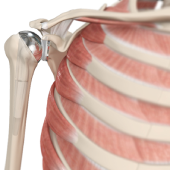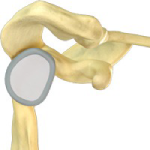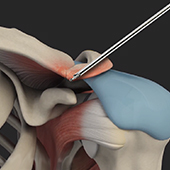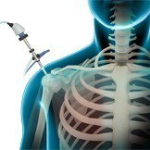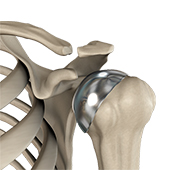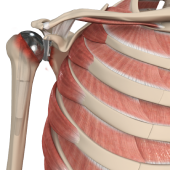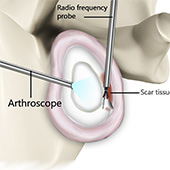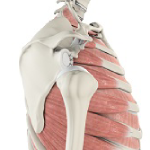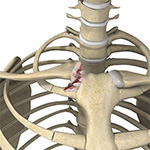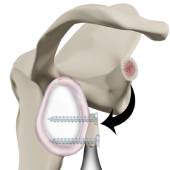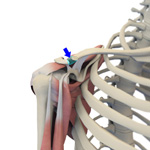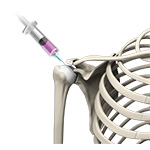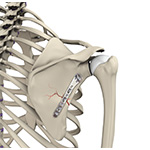- Anatomy
- Conditions
- Procedures
Rotator Cuff Repair
The rotator cuff is a group of 4 tendons that connect the muscles of the shoulder blade to the top of the humerus bone (humeral head). They function as a unit to keep the humeral head centred in the joint, but also provide stability to the shoulder and strength with certain movements. Due to the complex structure of the shoulder joint and the stresses placed upon it, these tendons are very vulnerable to injury.
Shoulder Joint Replacement
Arthritis of the shoulder may be caused by several different processes: Gradual wear and tear (osteoarthritis) – can be age related (degenerative) Chronic inflammatory disease – for example rheumatoid arthritis Post traumatic – following prior trauma or dislocation of the shoulder Many other less common conditions
Shoulder Stabilization
The shoulder joint is a complex structure that allows for a wide range of arm motion and strength. It is the most mobile and flexible joint in the body. To allow this mobility the shoulder has a large humeral head (ball) which forms a joint with a small flat glenoid (socket), a bit like a golf ball on a tee. As a result, the shoulder is vulnerable to injury, particularly instability.
AC Joint Stabilisation
Acromioclavicular (AC) joint stabilisation is a surgical procedure employed to treat severe cases of AC joint dislocation. AC joint dislocation is the separation of the collar bone or clavicle from the acromion (the top portion of the shoulder blade or scapula at the outer edge of the shoulder) due to severe trauma. AC joint dislocation usually occurs as a result of a direct fall on to the top of the shoulder which causes the shoulder blade to be forced downwards and the collarbone to pop up.
Shoulder Arthroscopy
Arthroscopy is a minimally invasive diagnostic and surgical procedure performed for joint problems. Shoulder arthroscopy is performed using a pencil-sized instrument called an arthroscope. The arthroscope consists of a light system and camera that projects images of the surgical site onto a computer screen for your surgeon to clearly view. Arthroscopy is used to treat disease conditions and injuries involving the bones, cartilage, tendons, ligaments, and muscles of the shoulder joint.
Partial Shoulder Replacement
Partial shoulder replacement, also called shoulder hemiarthroplasty, is a surgical procedure during which the upper bone in the arm (humerus) is replaced with a prosthetic metal implant, whereas the other half of the shoulder joint (glenoid or socket) is left intact.
Revision Shoulder Replacement
Total shoulder replacement, either anatomic or reverse, usually has very good and long-lasting results, but a revision surgery may occasionally be required. This may become necessary due to persistent pain, infection, stiffness, weakness due to rotator cuff failure, instability (dislocation), hardware loosening or wear, malposition or fracture.
Shoulder Preservation Surgery For Arthritis
Shoulder preservation surgery is any surgical procedure that is aimed at preserving the structure and function of the native shoulder. It may be a good option when non-surgical treatments fail to relieve shoulder symptoms as it is less invasive than shoulder joint replacement surgery. In general, it is preferred for the younger patient with shoulder arthritis where shoulder joint replacement ideally wants to be delayed.
Capsular Release
A capsular release of the shoulder is surgery performed to release a tight and stiff shoulder joint., Stiffness of the shoulder joint is most commonly the result of a condition called frozen shoulder or adhesive capsulitis. It can also follow shoulder trauma or be a complication of surgery to the shoulder. The procedure is usually performed arthroscopically through keyhole-size incisions.
Shoulder Labrum Tears
Traumatic injury to the shoulder or overuse of the shoulder can cause a labral tear. In addition, the ageing process may weaken the labrum, leading to labral injury secondary to wear and tear. Where damage to the labrum occurs will be determined by the direction of force applied to the shoulder and where the arm is positioned at the time. This may be anterior (front), posterior (back), superior (SLAP), or more widespread.
Sternoclavicular Joint Surgery
Sternoclavicular joint surgery may be employed to repair and restore function toa damaged or unstable sternoclavicular joint. The sternoclavicular (SC) joint is the joint between the breastbone (sternum) and the collar bone (clavicle). Injuries to this joint are called sternoclavicular joint injuries and can include stretching or tearing of the ligaments.
Latarjet Procedure
The Latarjet procedure is a surgical procedure performed to treat shoulder instability when bone loss is present. It is done by relocating a piece of bone called the coracoid process with an attached tendon to the front of the shoulder joint.
Distal Clavicle Excision
Distal clavicle excision is a procedure which involves removal of the outer end of the clavicle (collarbone) to treat shoulder pain and disability due to arthritis or impingement.
Shoulder Injections
The shoulder is prone to different kinds of injuries and inflammatory conditions. An shoulder injection is a minimally invasive procedure to treat pain and improve shoulder movement. It may be performed in the office setting or sometimes with the help of ultrasound or fluoroscopic imaging which allows the radiologist to precisely target the space involved.
Shoulder Fracture Care
A break in the bones that makes up the shoulder joint is called a shoulder fracture. The clavicle (collarbone) and top end of the humerus ( humeral head) closest to the shoulder are the bones that usually are fractured. The scapula, or shoulder blade, is not easily fractured because of its protective cover of surrounding muscles.
Preparing for Shoulder Surgery
Once you arrive at the hospital the nursing staff will admit you and take your recordings (temperature, pulse, blood pressure, and an ECG).
Complications of Shoulder Surgery
Modern shoulder surgery is extremely safe but all surgery has some degree of risk. Despite the highest standards of surgical practice complications are possible.



